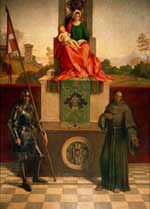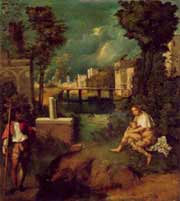 Giorgio da Castelfranco, known as Giorgione, was born in Castelfranco Veneto perhaps in 1477. There is so little information on his life that it is impossible to say much. According to Vasari he trained withGiovanni Bellini in Venice but there is no information on when this happened. His painting style was influenced by great painters like Antonello da Messina, Dürer, Leonardo, painters who lived in Venice and brought their style to the city.
Giorgio da Castelfranco, known as Giorgione, was born in Castelfranco Veneto perhaps in 1477. There is so little information on his life that it is impossible to say much. According to Vasari he trained withGiovanni Bellini in Venice but there is no information on when this happened. His painting style was influenced by great painters like Antonello da Messina, Dürer, Leonardo, painters who lived in Venice and brought their style to the city.
He painted two important works in Venice: a great painting for the Hall of Hearings in Palazzo Ducale (executed between 1507 and 1508; it perished) and the frescos on the façade of the Fondaco dei Tedeschi, painted in 1508. A fragment of a nude woman, now in the Academy’s Galleries, are all that remains of them.
A number of works, like the Shepherds’ Adoration (National Gallery of Washington), Adoration of the Magi, Madonna with Child, Judith, Laura, the Fire Trial, were allegedly painted by the artist in his early years.
Thanks to the notes of the Venetian nobleman Marcantonio Michiel, written between 1525 and 1543, Giorgione is known to have painted: The Tempest (in the Academy’s Galleries of Venice), the Three philosophers (Kunsthistorisches Museum of Vienna) and Venus (Dresda Picture Gallery). The Cupid and the landscape of this painting were probably painted by Titian. Giorgione’s works also include the Altar piece of Castelfranco in the church of St Liberale, pro bably painted in 1504, and Portrait of a Man in the Museum of St Diego in California.
bably painted in 1504, and Portrait of a Man in the Museum of St Diego in California.
The Altar piece of Castelfranco was commissioned by Tuzio Costanzo. It has a triangular structure and follows the traditional style used for holy conversations. Giorgione however placed the speakers in a natural landscape and not one with buildings. The altar piece is an important milestone for the affirmation of the tone-based painting of Veneto.
The typical elements of tone-based painting were set by Giorgione :"Outlines disappear, everything becomes softer and bathed in light; light seems to come from the objects themselves, a changeable, unstable and anxious light, like human feelings" (Zampetti).
Giorgio da Castelfranco strongly influenced artists like Titian and Sebastiano del Piombo. He
contracted the plague and died in Venice in the autumn of 1510.
G. Vasari, Vite de più eccollenti pittori, scultori et architetti, 1568
Avendo veduto Giorgione alcune cose di mano di Leonardo molto fumeggiate e cacciate, come s'è detto, terribilmente di scuro: e questa maniera gli piacque tanto che, mentre visse, sempre andò dietro a quella, e nel colorito a olio la imitò grandemente.
R. Borghini, Il Riposoi, 1584
Nel medesimo tempo che Firenze per l'opera di Lionardo s'acquistava fama, Vinegia parimenti per l'eccellenza di Giorgione da Castelfranco nel Trevigiano faceva risuanare il suo nome.
B. Berenson, I pittori veneziani del Rinascimento, 1894
Sarebbe effettivamente difficile dire di Giogione qualcosa di più di questo: che le sue opere non sono null'altro che il limpido specchio del rinascimento alla sua altezza suprema.
G. D'Annunzio, Il fuoco, 1898
Egli appare piuttosto come un mito che come un'uomo. Nessun destino di poeta è comparabile al suo, in terra. Tutto, o quasi, di lui s'ignora; e taluno non gli riconosce alcuna opera certa. Pure, tutta l'arte veneziana sembra infiammata dalla sua rivelazione.
P. Zampetti, Introduzione a Giorgione ei Giorgioneschi, catalogo della mostra, 1955
Il segno scompare tutto diventa più morbido e permeato di luce: una luce che sembra scaturire dalle cose stesse, mutevole, instabile, trepidante come il sentimento umano.